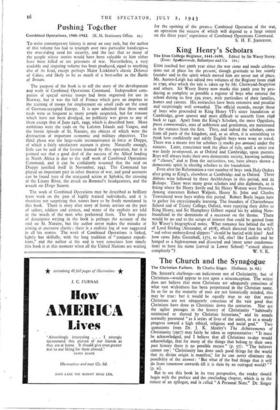King Henry's Scholars
Brox reached her 5ooth year since the war came and made celebra- tions out of place for the present; though gratitude to her saintly founder and to the spirit which moved him are never out of place. Mr. Austen-Leigh has edited two volumes of the Register from 1698 to 179o, after which the tale is taken up by Mr. Chetwynd-Stapylton and others. Sir Wasey Sterry now marks this 5ooth year by pro- ducing as complete as possible a register of boys who entered the school during its first 25o. years, with particulars of their families, homes and careers. His researches have been extensive and peculiar and•surprisingly well rewarded. The official records, except those of boys who proceeded to King Henry VI's sister foundation at Cambridge, grow sparser and more difficult to unearth from 1698 back to I441. Apart from the King's Scholars, the mere Oppidans, pueri commensales, Sons of noblemen and gentlemen, are mentioned in the statutes from the first. They, and indeed the scholars, came from all parts of the kingdom, and, as so often, it is astonishing to think how confidently and safely English boys were wont to travel. There was a means test for scholars (5 marks per annum) under the statutes. Later, conscience took the place of rule, until a strict test was lately re-imposed, as at Oxford and Cambridge, upon parents. Boys will always make their own democratic society, knowing nothing of " classes," and at Eton the authorities, too, have always shown a democratic spirit in electing scholars to the foundation.
Even after the Reformation a vast number of boys took Holy Orders after going to King's, elsewhere at Cambridge and to Oxford. Three Abbots were followed by three Archbishops in this period, and 22 Bishops. There were many great scholars and also diplomats, as is fitting where Sir Henry ,Savile and Sir Henry Wotton were Provosts. Among statesmen Robert Walpole, Henry St. John and Charles Townshend were boys within this period. Robert Boyle began here to gather his encyclopaedic learning. The founders of CharterhOuse School and of Trinity College, Oxford, were repaying their debts to King Henry, and Sir Humphrey Gilbert repaid his by adding New- foundland to the dominions of a successor on the throne. There would be no end to the scraps of interest that could be quoted from Sir Wasey's biographical notes. What romance lies behind the will of Lord Stirling (Alexander, of 1678), Which directed that his wife's " red velvet embroydered slippers " should be buried with him? And how came John Greenhall, 1571, to fall, alas! like Lucifer and be hanged as a highwayman and dissected and (most utter condemna- tion) to have his name (carved in Lower School) " erased almost


























 Previous page
Previous page